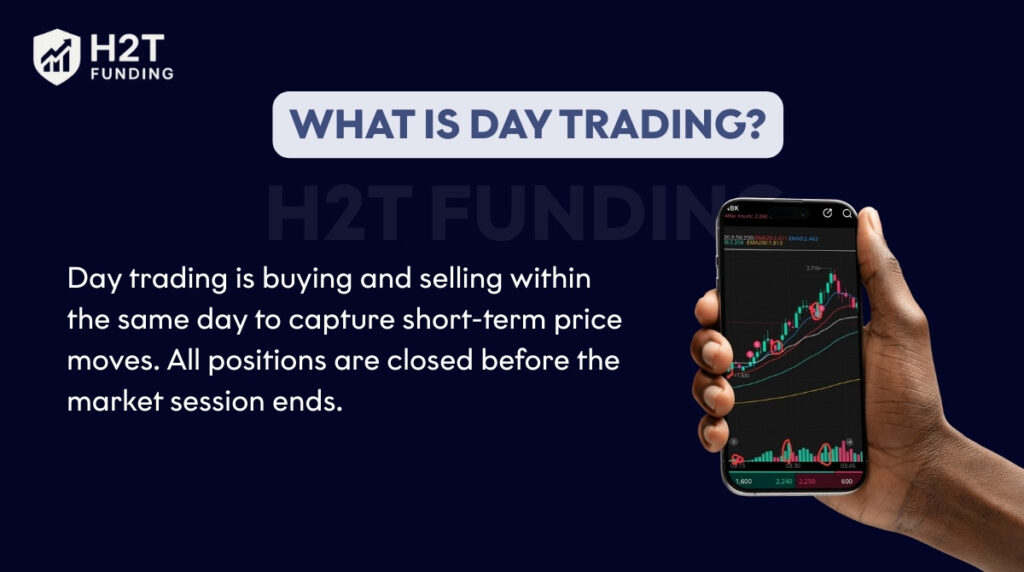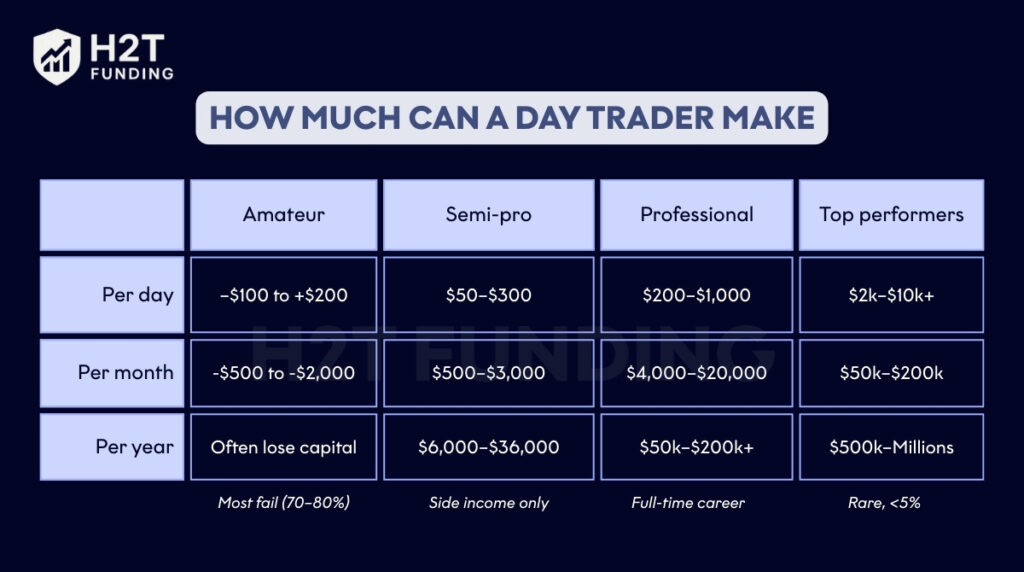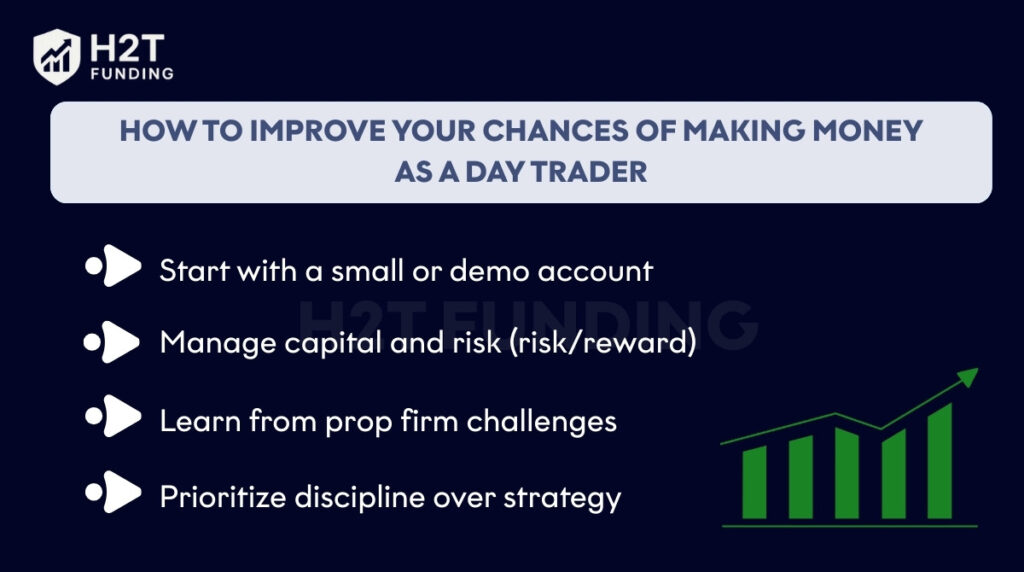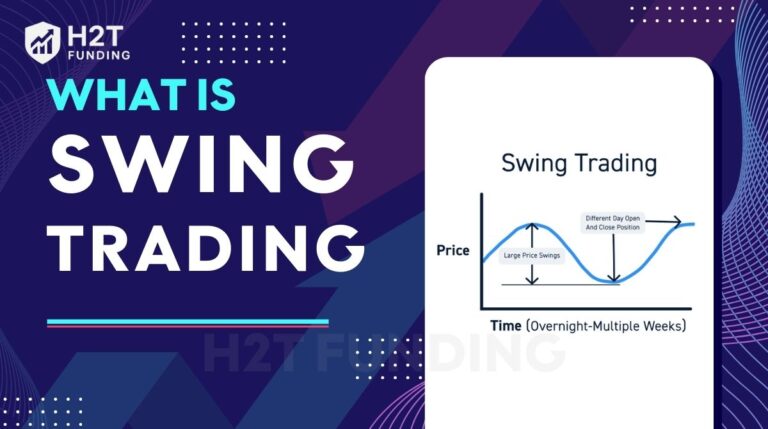If you have ever wondered “How much can a day trader make?”, it’s a question that comes up often in trading circles. Social media often shows flashy screenshots of big profits, but the truth is more complex.
The average income varies widely depending on skill, capital, and discipline. This is why discussions about day trading often revolve around the average income rather than just isolated success stories.
I remember when I first started, believing those stories, only to realize how quickly losses can erase gains without discipline.
Key takeaways:
- Income varies widely: Day trading results range from losses to six-figure earnings depending on capital, discipline, and experience level.
- Most traders lose money: Studies show that 70–90% of beginners fail within the first year due to poor risk control and unrealistic expectations.
- Realistic ranges exist: Semi-professionals may earn hundreds to a few thousand dollars per month, while only a small percentage of professionals reach consistent six-figure incomes.
- Success depends on multiple factors: Account size, strategy, risk management, market dynamics, and emotional discipline all directly impact outcomes.
- Different paths bring different results: Retail traders, prop firm traders, and hedge fund traders face unique advantages, challenges, and income potential.
1. What is day trading mean?
Day trading is the practice of buying and selling financial instruments within the same day to capture short-term price movements. Unlike swing traders who hold positions for days or weeks, day traders close all trades before the market session ends.

The goal is to profit from small price fluctuations in assets such as stocks, forex, futures, or crypto. To do this effectively, traders often rely on leverage, a clear trading strategy, technical analysis, and fast trading tools. A solid trading strategy combined with effective technical analysis is essential to navigate short-term price movements successfully.
According to CME Group (2024), day traders typically manage dozens of trades in a single session, which requires both precision and discipline.
2. Why people ask: Can you really make money day trading?
Many new traders are drawn to day trading by the promise of financial independence. The lifestyle appears appealing, with the possibility of working from home, choosing your own hours, and earning money daily.
In reality, expectations are often shaped by conflicting stories, while actual results depend greatly on market conditions and the trader’s experience level.
2.1. The promise versus the reality
Platforms like YouTube and Instagram highlight quick wins and promote the idea that anyone can make $1,000 a day with little effort. This creates unrealistic expectations about earning potential while ignoring the financial risks involved. These messages fuel the belief that day trading is a shortcut to wealth.
A large-scale study of Brazilian equity futures day traders found that 97% lost money after 300 trading days. Only 1.1% earned more than the local minimum wage (Chague, De-Losso, Giovannetti, & da Silva, 2020).
The Commodity Futures Trading Commission (CFTC, 2023) warns: “Trading is not a guaranteed income stream, and losses can exceed deposits.”
2.2. Why skepticism is healthy
Skepticism is justified because traders hear inconsistent accounts. Some claim six-figure success, while others admit to losing everything. I have seen people quit within weeks because their results did not match the hype.
A healthy dose of skepticism prevents unrealistic expectations. Long-term success depends on career longevity and consistent trading performance, not just short bursts of profit. Instead of chasing a single income figure, it is better to examine the factors that shape results. This helps explain why most traders lose while only a few succeed consistently.

So, can you really make money day trading? Yes, but only a small minority succeed. Most traders lose money, while those who do profit rely on capital, discipline, and experience rather than luck or quick wins.
3. Answer: How much can a day trader make
Day trading income ranges from negative (losses) to six figures per year, depending on experience, capital, and discipline. To answer how much a day trader makes on average, it helps to look at different trader categories.
3.1. Amateur or beginner traders
Most beginners lose money. One major reason is their inability to manage market volatility in fast-moving conditions and shifting market dynamics.
According to NASAA (2022), 70–80% of new traders fail within the first year. Losses often happen because of over-leverage, chasing trades, and a lack of risk management.
- Per day: anywhere from –$100 to +$200
- Per month: often a net loss of $500 to $2,000
- Per year, many see their initial capital reduced or wiped out
I remember my first three months trading forex on a $2,000 account. Some days I made $150, but a single bad trade could wipe out a week of progress. This is the reality most new traders face.
3.2. Semi-professional traders
These traders often treat day trading as a side income. They may have $10,000–$50,000 in trading capital and some experience in reading charts, managing risk, and sticking to rules.
- Per day: $50 to $300
- Per month: $500 to $3,000
- Per year: $6,000 to $36,000
Semi-professionals may not replace a full-time salary, but can supplement income. For example, a forex trader with a $20,000 account targeting 1–2% monthly growth might average $200–$400 per month if disciplined and with emotional control.
Academic research shows that very few day traders consistently outperform the market. In Taiwan data, less than 3% of traders were predictably profitable, while the vast majority failed to sustain returns (Barber, Lee, Liu, & Odean, 2017). This underscores that even semi-professional traders face long odds.
3.3. Professional full-time traders
Professionals trade with $50,000+ in their own capital or trade funded accounts of $100,000–$500,000 through prop firms. They usually follow strict strategies and risk management.
- Per day: $200 to $1,000
- Per month: $4,000 to $20,000
- Per year: $50,000 to $200,000+
At this level, position sizing, commissions, trading sessions, and reliable trading platforms all make a noticeable difference in results.
Industry data gives some context: the U.S. Bureau of Labor Statistics reports a median annual wage of $78,140 (May 2024) for Securities, Commodities, and Financial Services Sales Agents. While this is not specific to retail day traders, it illustrates income levels for professionals in comparable trading roles (BLS, 2024).
Regulators like FINRA caution that even experienced traders must follow strict Pattern Day Trader (PDT) rules and margin requirements. Losses can also exceed deposits if risk controls fail (FINRA, 2024; CFTC, 2023).
3.4. Top performers
At the very top, hedge fund managers and elite prop firm traders can earn six or seven figures annually. This is a small group, probably less than 5% of all active day traders.
- Per day: $2,000 to $10,000+
- Per month: $50,000 to $200,000
- Per year: $500,000 to several million

Jack Schwager’s Market Wizards (2012) highlights traders who made millions, but these cases are rare. They usually involve decades of experience, strong discipline, institutional resources, and large amounts of capital. Even then, income fluctuations remain a constant challenge.
4. Factors that affect a day trader’s income
How much money you can make from day trading depends on several factors. Even two traders using the same strategy may earn very different results because their capital, discipline, and psychology are not the same.
4.1. Starting capital
The size of your trading account determines your earning potential. With $1,000, even a 5% monthly return equals only $50. With $50,000, that same 5% means $2,500. Many beginners expect big profits with small accounts, but realistic growth usually scales with capital.
4.2. Experience level and skill
A skilled trader knows when to enter and exit, how to manage risk, and when to stay out of the market.
In my early months, I jumped into every price move and lost money quickly. After years of practice, I learned that waiting for high-probability setups often made the difference between consistent profit and random results. Refining trading methods is a crucial part of this process.
4.3. Strategy and discipline
Having a clear strategy is not enough if you cannot stick to it. Traders who overtrade or move stop losses often end up losing more than those who follow strict rules. A simple strategy with discipline often outperforms a complex system used carelessly.
4.4. Market choice
Income potential also depends on what you trade:
- Stocks: higher volatility, pattern day trading rule in the U.S. requires $25,000 minimum capital.
- Forex: lower barrier to entry, operates 24/5, but spreads and leverage risks are high.
- Futures: deep liquidity, but margin requirements and volatility can be challenging.
- Crypto: available 24/7, highly volatile, but the risk of large swings is greater.
4.5. Leverage and risk management
Leverage magnifies both gains and losses. A forex trader using 30:1 leverage might double an account quickly or blow it up in one day, especially in markets with thin market liquidity.
According to CME Group (2024), professional traders often risk no more than 1–2% of capital per trade to stay sustainable.
4.6. Time commitment and psychology
Day trading is mentally intense. Traders who monitor charts full-time have an edge over those who check trades occasionally. Emotional control is just as important as technical skill. Accepting drawdowns, avoiding revenge trading, and managing stress are critical to long-term success.
These factors explain why how much a day trader can make per day has no single answer. The same market can create losses for one trader and steady income for another, depending on how each handles these variables.
5. Retail day trader vs prop firm trader vs hedge fund trader
Not all day traders operate under the same conditions. Where you trade and whose money you use significantly impacts how much money a day trader makes.
5.1. Retail day traders
Retail traders use their own money in personal brokerage or forex accounts. They often trade alone without the support of a trading community, which can make the learning curve harder.
Their main advantage is flexibility; they can trade whenever they want and keep all profits. But they face limitations: small account sizes, strict margin rules (such as the U.S. $25,000 pattern day trading rule), and high emotional pressure.
- Capital base: usually $1,000 to $50,000
- Income potential: –$5,000 (loss) to +$50,000 per year
- Key challenge: surviving long enough to gain skill and consistency
Advantages:
- Full ownership of profits
- Total independence in strategies and trading times
- Direct control without needing approval from firms
Disadvantages:
- Limited by personal capital and margin rules
- Higher emotional stress and financial risk
- Difficult to scale income quickly
Retail trading is the most accessible path but also the riskiest, demanding resilience and discipline to succeed.
5.2. Prop firm traders
Proprietary trading firms (prop firms) give traders access to larger accounts, often $25,000 to $200,000 or more, in exchange for a profit split. Passing an evaluation challenge is required. With more capital, traders can aim for steadier returns without risking personal funds.
- Capital base: $50,000 to $500,000 (funded account)
- Income potential: $20,000 to $150,000 per year, depending on profit split
Advantages:
- Access to large trading capital without personal risk
- Potential to scale profits faster than retail trading
- Risk-sharing model reduces financial burden
Disadvantages:
- Profit splits reduce total earnings
- Must pass strict evaluation challenges with rules
- Limited freedom since firms may restrict strategies, assets, or risk levels
Case study: A trader with a $100,000 funded account making 5% monthly earns $5,000. If the profit split is 80/20, the trader keeps $4,000. Over 12 months, that is $48,000, which is comparable to a mid-level salary.
For many traders, prop firms strike a balance between opportunity and security, though success depends on meeting firm requirements.
Don’t miss out:
5.3. Hedge fund traders
Hedge fund traders manage millions in institutional capital. They receive a base salary plus performance bonuses. Unlike retail or prop traders, they trade as part of a team with advanced tools, research, and strict risk controls.
- Capital base: millions to billions of dollars
- Income potential: $100,000 to $500,000+ annually for junior roles, several million for senior managers
- Advantage: steady income plus high upside, but limited personal freedom
Advantages
- Stable salary plus lucrative performance bonuses
- Access to institutional research, advanced technology, and global markets
- Lower personal financial risk compared to retail traders
Disadvantages
- Limited personal freedom as a strategy must align with the firm’s mandates
- High-pressure environment with demanding performance expectations
- Entry barriers that require advanced degrees, a proven track record, or strong connections
Hedge fund trading is the most rewarding in terms of income and resources, but only those with top credentials and experience can break in.
This comparison shows how much money you can make as a day trader depends heavily on your setup. Retail traders risk their own capital, prop traders leverage firm funding, and hedge fund traders trade institutionally with salaries and bonuses, which changes how much money a day trader can make in each path.
6. Examples of realistic day trading earnings
Traders often ask how much can a day trader make in one day, hoping for a clear number. The reality is that income varies greatly, and no two traders earn the same. To set realistic expectations, it helps to review scenarios across different time frames.
In practice, how much money a day trader makes depends on risk per trade, win rate, and consistency. The following examples show what results can look like on a daily, monthly, and annual basis.
6.1. Daily outcomes
On a typical trading day, results can swing widely:
- Best case: +$500 to +$1,000 for a skilled trader with a $50,000–$100,000 account.
- Average case: +$100 to +$300 for consistent traders with smaller accounts or conservative strategies.
- Worst case: –$500 to –$2,000 (or more) if over-leveraged during volatile news events.
For example, during Non-Farm Payroll releases in forex, even a stop-loss can slip 20–30 pips, turning a planned $200 loss into a $600 drawdown.
6.2. Monthly outcomes
Month-to-month, outcomes show clearer patterns:
- Beginner: often down –$1,000 to –$3,000 after fees and mistakes.
- Semi-professional: +$500 to +$3,000, treating trading as part-time income.
- Professional: +$4,000 to +$20,000, assuming steady performance and risk control.
When I tracked my results after one year, I averaged around $1,200 per month on a $25,000 account. That was only after reducing overtrading and focusing on one setup.
You may be interested in this article: How to track expenses: A simple guide for beginners
6.3. Annual outcomes
Looking yearly gives the most realistic picture:
- Beginner: often ends the year negatively.
- Semi-professional: $6,000–$36,000 annually.
- Professional: $50,000–$200,000 annually.
- Top tier (prop/hedge fund): $500,000+ annually, but very rare.
As Investopedia (2024) notes, “day trading is not a consistent paycheck. It requires years of practice, adequate capital, and the ability to control risk.”
These examples show how much the average day trader’s earnings are far less than advertised online. Most beginners lose, semi-pros may supplement income, and only seasoned professionals reach sustainable living levels.
In short, how much an average day trader can make is usually modest unless capital and discipline are strong.
7. Common myths and misconceptions about day trading income
When people ask how much day traders can make, they often run into myths that distort reality. Clearing up these misconceptions helps set realistic expectations.
| Myth | Reality |
|---|---|
| Anyone can make $1,000 a day. | Possible only with large capital, discipline, and years of experience. Beginners with small accounts usually lose money chasing this. |
| Day trading is a quick path to wealth. | Most traders lose in their first year. Consistency comes after years of practice, not months. |
| The average day trader makes a comfortable living. | Most break even or lose money. Only a small minority with larger accounts or prop firm backing earn a steady income. |
| More trades mean more profits. | Overtrading increases costs and mistakes. Professionals focus on fewer, higher-quality setups. |
| Day trading is easy with the right strategy. | No single strategy works forever. Markets change, requiring adaptation, risk control, and discipline. |
| Technology alone ensures success. | Tools help execution, but they cannot replace skill, psychology, and risk management. |
8. How to improve your chances of making money as a day trader
Profitability in day trading comes from consistent habits, careful risk management, and emotional control. There is no guaranteed path to success, but four steps can greatly improve your chances.
8.1. Start with a small or demo account
Many beginners lose money because they risk too much too early. Starting with a demo account or a small live account helps you learn how to execute trades and test strategies in a safer way. This stage should be seen as training, not a way to get rich.
I have seen new traders open large accounts and lose thousands within weeks. In contrast, those who begin with $500 to $1,000 and keep their risk small gain valuable experience without heavy losses. The goal is to build discipline and confidence before scaling up.
8.2. Manage capital and risk (risk/reward)
Risk management is the most important factor in long-term trading. Professional traders usually risk only 1 to 2 percent of their account on each position. This rule protects them from losing streaks and ensures that no single trade can destroy their account.
For example, on a $10,000 account, limiting risk to $100 per trade keeps losses manageable. Even after five losing trades in a row, the account would still have $9,500 left. That safety margin allows the trader to recover when profitable setups appear.
8.3. Learn from prop firm challenges
Prop firm evaluations are strict, but they can be excellent training. Rules such as profit targets, daily loss limits, and maximum drawdowns are designed to teach discipline and capital protection. Following them builds habits that apply to all forms of trading.
Imagine taking a $100,000 evaluation account where the target is an 8 to 10 percent profit while avoiding more than a 5 percent daily loss. A trader under these conditions must plan carefully and avoid reckless decisions. Even if the challenge is not passed, the lessons gained are valuable for personal trading.
You may also like this article: How to pass FTMO challenge: My proven strategy
8.4. Prioritize discipline over strategy
Success in trading is less about finding the perfect strategy and more about following your rules with discipline. Many traders fail because they move stop-losses, overtrade, or act on emotions after losses.
Building discipline means waiting for quality setups and having the strength to accept small losses without changing your plan. Keeping a trading journal, reviewing mistakes weekly, and stepping away from the screen after a losing streak are all effective ways to stay consistent.

By following these four steps, you give yourself a much better chance of becoming part of the minority who achieve consistent profitability. Instead of only asking how much a day trader makes, you focus on building the process that makes sustainable success possible.
9. FAQs
With a $100k account, disciplined traders often aim for 2 to 5 percent monthly returns. That equals about $2,000 to $5,000 per month. Prop firm traders with this account size may earn similar numbers depending on the profit split.
On a $10k account, realistic returns are $200 to $500 per month if trading conservatively. While higher returns are possible, they usually come with higher risk and a greater chance of account loss.
Yes, but only a small percentage manage to do so. Professionals with large accounts or prop firm funding can earn a steady income. Most beginners, however, lose money in their first year.
Most beginners lose money in the first months. Small wins may happen, but losses usually outweigh them until the trader develops discipline and risk control.
With a $25k account, aiming for 0.5 to 1 percent daily can produce around $100. Smaller accounts would need much higher risk, which is usually not sustainable.
Research shows that only 10 to 20 percent of day traders are profitable in the long run. The majority either break even or lose money.
They do not guarantee profits, but they give access to larger capital. This makes it easier to grow income with smaller percentage returns, as long as the trader can follow strict rules.
It is possible with large accounts of $50k to $100k or more, but it is not realistic for beginners. Only experienced traders with strong discipline achieve this consistently.
Yes, but this is rare. Most millionaire traders reach that level by managing large capital through hedge funds or prop firms, not from small retail accounts.
Yes, but the results will be extremely limited. With $100, even a 10 percent gain is only $10. The main benefit of such a small account is practice, not income.
10. Conclusion
So, how much can a day trader make? Put simply, how much can you make as a day trader depends on capital, risk control, and consistency. Most beginners lose money, some semi-professionals manage to earn a side income, and only a small percentage of full-time traders achieve consistent six-figure results.
Millionaire day traders exist, but they are rare and usually backed by large capital, prop firms, or hedge funds.
From my own journey, I remember making $150 in a single day early on and feeling unstoppable, only to lose twice as much the next week. That experience taught me that income is not about one good day, but about consistency, discipline, and risk control.
If you want to improve your chances, focus on starting small, managing risk carefully, learning from structured environments like prop firm challenges, and prioritizing discipline over strategy. With time and patience, day trading can become a sustainable source of income, though it will never be a guaranteed path to wealth.
Enhance your knowledge by exploring more about Prop Firms & Trading Strategies at H2T Funding.





